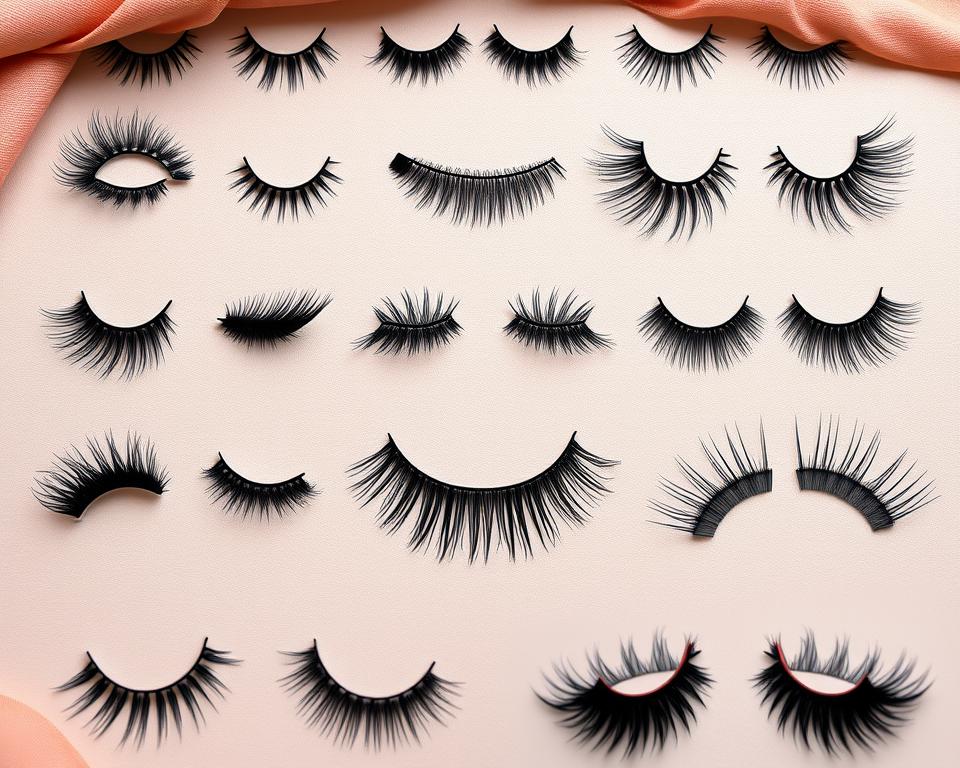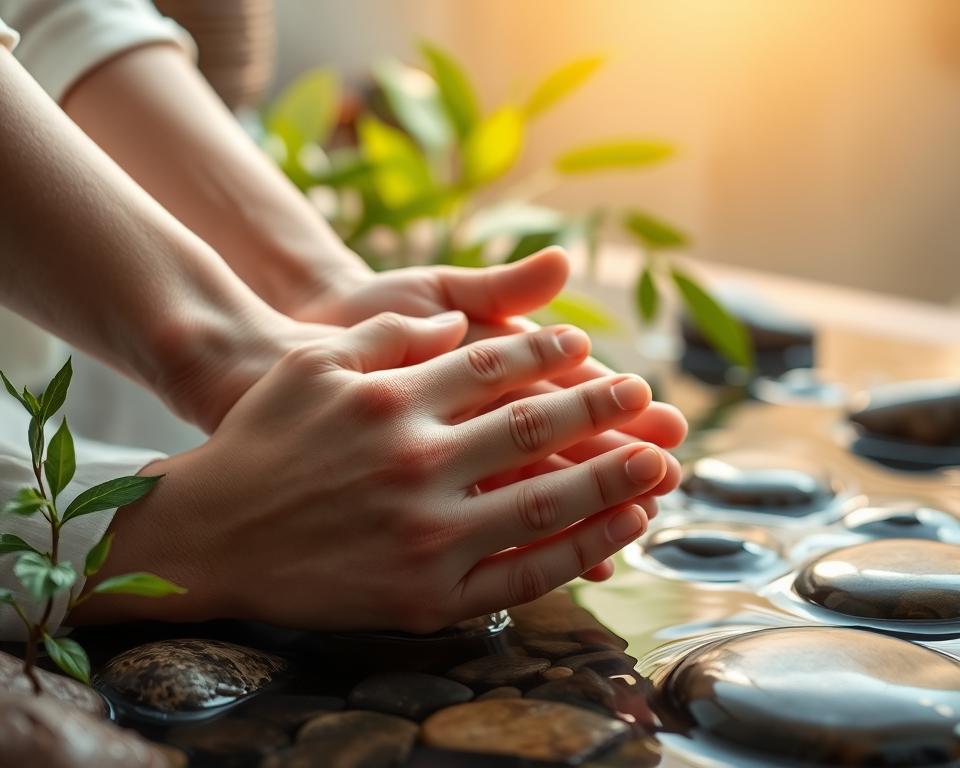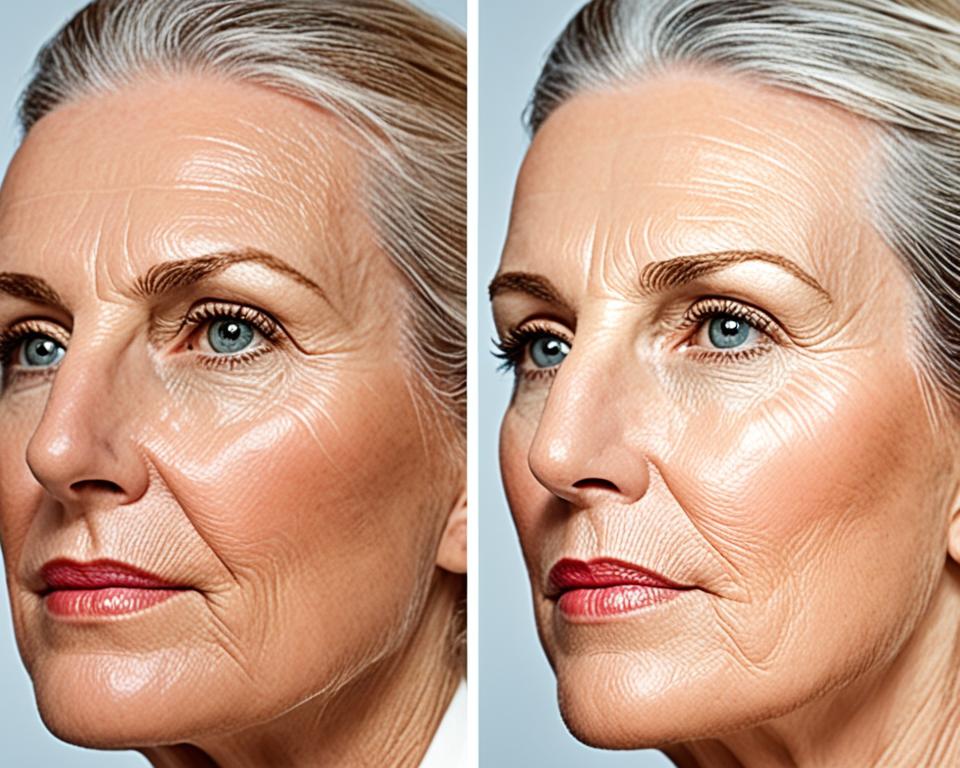
Welcome to our comprehensive guide on sun damaged skin. In this article, we will explore the visual impact of sun damaged skin through compelling pictures, helping you understand the consequences of UV exposure on your skin.
As the saying goes, a picture is worth a thousand words. By visualizing the effects of sun damaged skin, you can gain a deeper understanding of the potential risks and long-term consequences associated with prolonged UV exposure.
These powerful images depict the visible effects of sun damage on the skin, including sunburns, sun spots, and other manifestations. By examining these pictures, you can recognize the signs and symptoms of sun damaged skin, enabling you to take proactive steps to protect and heal your skin.
Throughout this article, we will delve into various aspects of sun damaged skin, including the significance of protecting your skin from the sun’s harmful UV rays, different treatment options available, and the link between sun exposure and skin cancer. We will also provide practical tips and lifestyle modifications to prevent sun damage and nourish your skin with proper skincare.
So, let’s dive in and explore the effects of sun damaged skin together. Discover the importance of sun protection, learn how to recognize the signs of sun damaged skin, and find effective ways to maintain healthier and radiant skin.
Read more interesting information at ::nanbacity
Recognizing the Signs of Sun Damaged Skin
Sun damaged skin can manifest in various ways, and recognizing the signs and symptoms is essential for taking proactive steps to protect and heal your skin. By knowing what to look for, you can detect early indications of sun damage and implement effective measures to maintain healthy skin. Here are some common signs to watch out for:
- Uneven skin tone: Sun damage can cause uneven pigmentation, resulting in areas of hyperpigmentation (dark spots) or hypopigmentation (lightened patches). These uneven skin tones are often a telltale sign of sun damage.
- Wrinkles and fine lines: Prolonged sun exposure accelerates the aging process, leading to the development of wrinkles and fine lines on the skin. These visible signs of aging can be indicative of sun damage.
- Dryness and dehydration: The sun’s UV rays can deplete the skin’s natural moisture, leaving it dry and dehydrated. If you notice persistent dryness or flakiness, it could be a sign of sun damage.
- Texture changes: Sun damaged skin may exhibit changes in texture, such as roughness or a leathery feel. These textural abnormalities are often caused by long-term sun exposure.
- Hyperpigmented spots: Dark brown or tan spots on the skin, commonly known as sun spots or age spots, can be a visible indication of sun damage.
- Actinic keratosis: These rough, scaly patches on the skin can develop as a result of prolonged sun exposure. Actinic keratosis should be monitored closely, as it can potentially progress to skin cancer.
Observing these signs of sun damaged skin is crucial for taking action and protecting your skin from further harm. If you notice any of these symptoms, it’s recommended to consult with a dermatologist for a comprehensive evaluation and personalized treatment plan.
“Being able to identify the signs of sun damaged skin empowers individuals to take control of their skin health and make informed decisions regarding sun protection and skincare.”
To visually demonstrate the signs of sun damaged skin, take a look at the image below:
Image: Signs of Sun Damaged Skin
Understanding the Effects of UV Exposure
UV exposure can have far-reaching effects on your skin, both in the short term and over time. Understanding these effects is key to protecting your skin and minimizing sun damage. Let’s explore the long-term consequences and potential risks associated with prolonged exposure to UV rays.
One of the immediate effects of sun damaged skin is sunburn. When your skin is exposed to excessive UV radiation, it can become red, inflamed, and painful. This damage occurs due to the DNA in your skin cells being damaged by the UV rays. Sunburn is not just a temporary inconvenience; it can lead to long-term consequences such as premature aging, wrinkles, and an increased risk of skin cancer.
But the effects of UV exposure don’t stop at sunburn. Over time, accumulated UV damage can cause a range of skin concerns. One significant effect is the development of sun spots, also known as lentigines. These are darkened areas of the skin that appear as small, flat spots or patches. Sun spots are typically more common in areas that receive the most sun exposure, such as the face, hands, and shoulders.
In addition to sun spots, UV exposure can also lead to uneven skin tone, pigmentation changes, and a loss of elasticity. These effects can make your skin appear dull, aged, and less vibrant. Furthermore, prolonged sun damage weakens the skin’s natural barrier, making it more susceptible to external irritants and allergens.
It’s important to note that the effects of sun damaged skin are not limited to cosmetic concerns alone. Prolonged UV exposure is a significant risk factor for skin cancer, including melanoma, the most aggressive form of skin cancer. Skin cancer is becoming increasingly prevalent, making sun protection and early detection crucial for maintaining your skin’s health and overall well-being.
By understanding the effects of UV exposure, you can take proactive steps to protect your skin and minimize damage. From wearing broad-spectrum sunscreen and protective clothing to seeking shade during peak sun hours, practicing sun-safe habits can go a long way in preserving your skin’s youthful appearance and reducing your risk of sun-related skin issues.
Take a moment to reflect on the long-term consequences and potential risks associated with sun damaged skin. The visual impacts of sun damage can be severe, but with proper protection and care, you can maintain healthier, more radiant skin.
Visualizing Sun Damage on the Skin
Witness the profound effects of sun damage on the skin through a captivating collection of images. These visuals allow you to explore and identify common manifestations of sun damage, such as sun spots, and sunburned skin. Let’s delve into the world of sun-damaged skin as we visually uncover its impact.
Identifying Sun Spots
Sun spots, also known as solar lentigines or age spots, are small, darkened patches that appear on the skin due to excessive sun exposure. They typically develop on areas frequently exposed to the sun, such as the face, hands, and shoulders.
Sun spots are caused by the overproduction of melanin, the pigment responsible for skin coloration. The cumulative effects of UV radiation trigger an increase in melanin production, resulting in the formation of these pigmented spots.
These images highlight the distinct appearance and characteristics of sun spots, helping you identify them on your own skin for early detection and necessary precautions.
Recognizing Sunburned Skin
Sunburn is a common consequence of prolonged sun exposure without adequate protection. It occurs when the skin’s defenses are overwhelmed by ultraviolet (UV) radiation, leading to redness, pain, and inflammation.
These images vividly portray sunburned skin in various degrees of severity, allowing you to recognize the visual indicators of overexposure. From mild pinkness to intense redness and blistering, the visuals remind us of the importance of sun protection.
Understanding Skin Damage
By visualizing sun damage on the skin, we can better comprehend the harmful effects of UV radiation. These images serve as a reminder to take proactive measures in safeguarding our skin from the damaging consequences of prolonged sun exposure. Whether it’s regular sunscreen application, seeking shade, or wearing protective clothing, every effort counts in maintaining healthy and radiant skin.
| Sun Spots | Sunburned Skin | |
|---|---|---|
| Appearance | Darkened patches | Redness and inflammation |
| Causes | Excessive sun exposure | UV radiation |
| Common Locations | Face, hands, shoulders | Exposed areas |
The Importance of Skin Protection
Protecting your skin from the harmful effects of the sun is vital for maintaining its health and appearance. Sun damage, caused by prolonged exposure to ultraviolet (UV) rays, can lead to a range of skin concerns, including premature aging, wrinkles, sagging, sunspots, and an increased risk of skin cancer. By taking preventive measures, you can minimize the risk of sun damage and keep your skin looking and feeling its best.
Understanding UV Rays
UV rays are a type of radiation emitted by the sun. There are two main types of UV rays that reach the Earth’s surface: UVA and UVB. UVA rays have longer wavelengths and can penetrate deep into the skin, causing long-term damage and premature aging. UVB rays, on the other hand, have shorter wavelengths and primarily affect the outer layer of the skin, leading to sunburns and an increased risk of skin cancer.
Both UVA and UVB rays contribute to sun damage and should be considered when protecting your skin.
Prevention Strategies
Preventing sun damage to your skin requires a combination of protective measures. Here are some effective strategies you can incorporate into your daily routine:
- Apply sunscreen: Use a broad-spectrum sunscreen with an SPF of 30 or higher and apply it generously to all exposed areas of your skin. Reapply every two hours and after swimming or sweating.
- Seek shade: Limit your time in direct sunlight, especially during peak hours when UV rays are strongest (typically between 10 a.m. and 4 p.m.).
- Wear protective clothing: Cover your skin with long sleeves, pants, and a wide-brimmed hat to minimize sun exposure.
- Use sunglasses: Protect your eyes by wearing sunglasses that block both UVA and UVB rays.
- Avoid tanning beds: Tanning beds emit harmful UV radiation and increase the risk of skin damage and cancer.
Visualizing the Impact
Take a look at this image to see a visual representation of the harmful effects of sun damage on the skin:
| Effects of Sun Damage | Prevention Strategies |
|---|---|
| Premature aging | Apply sunscreen daily and wear protective clothing |
| Sunburns | Seek shade and avoid excessive sun exposure |
| Wrinkles and sagging | Use skincare products with antioxidants and protect your skin from UV rays |
| Sunspots | Apply sunscreen to prevent the formation of sunspots |
| Increased risk of skin cancer | Take all preventive measures, including regular use of sunscreen and wearing protective clothing |
By implementing these prevention strategies, you can reduce the chances of sun damage, maintain healthier skin, and promote long-term skin health.
Treating Sun Damaged Skin
When it comes to sun damaged skin, there are various treatment options available to address the visible effects of UV exposure. From topical creams to dermatological procedures, finding the right approach for your skin can help restore its health and appearance.
One effective treatment for sun damaged skin is the use of topical creams that contain ingredients such as retinol, vitamin C, and hyaluronic acid. These creams can help reduce the appearance of sun spots, fine lines, and wrinkles, while also improving overall skin texture and tone. Regular use of these creams can promote skin renewal and collagen production, resulting in a more youthful complexion.
Laser therapies are another popular option for treating sun damaged skin. These procedures use concentrated beams of light to target specific areas of discoloration, sun spots, and other visible signs of sun damage. Laser treatments can effectively remove damaged skin cells and stimulate the production of new, healthier skin cells. However, it’s important to consult with a qualified dermatologist to determine the most suitable laser treatment for your skin type and condition.
Chemical peels are also commonly used to treat sun damaged skin. This procedure involves applying a chemical solution to the skin, which causes the top layer to peel off, revealing a fresh layer underneath. Chemical peels can help reduce the appearance of sun spots, hyperpigmentation, and uneven skin tone. They can also improve the overall texture and smoothness of the skin. It’s essential to have chemical peels performed by a trained professional to ensure optimal results and minimize the risk of complications.
In some cases, more intensive dermatological procedures may be recommended to address severe sun damage. These procedures may include microdermabrasion, dermabrasion, or intense pulsed light (IPL) therapy. Each of these treatments aims to resurface the skin, improve texture, and address specific sun damage concerns.
Remember, treating sun damaged skin is not a one-size-fits-all approach. It’s crucial to consult with a dermatologist or skincare professional to determine the most suitable treatment options for your specific needs and concerns.
By taking proactive steps to treat sun damaged skin, you can reverse the effects of UV exposure and restore your skin’s health and vitality. Whether you choose topical creams, laser therapies, chemical peels, or other dermatological procedures, addressing sun damage is essential for achieving a more youthful and radiant complexion.
Understanding Sunburn and Its Consequences
Sunburns are more than just a temporary discomfort; they can have long-lasting effects on your skin. When the skin is exposed to excessive UV radiation, it becomes inflamed, leading to the familiar redness, pain, and peeling associated with sunburns. However, the consequences of sunburns go beyond these immediate symptoms, as they contribute to the long-term effects of sun-damaged skin.
One of the primary consequences of sunburns is an increased risk of skin cancer. Studies have shown that experiencing multiple severe sunburns throughout life significantly raises the likelihood of developing skin cancer, including melanoma. The DNA in skin cells can be damaged by UV radiation, leading to mutations that can trigger cancerous growth. Therefore, minimizing sunburns is crucial in reducing the risk of skin cancer.
Sunburns also accelerate the aging process of the skin. The intense UV exposure from a sunburn can cause the breakdown of collagen and elastin fibers, which are responsible for maintaining the skin’s firmness and elasticity. As these structures degrade, the skin becomes more prone to wrinkles, fine lines, and sagging. Consequently, sunburns contribute to premature aging, causing the skin to appear older than it actually is.
Moreover, repeated sunburns can result in the development of dark spots and hyperpigmentation. When the skin is damaged by UV radiation, it produces an excess of melanin, the pigment responsible for skin color. This overproduction can lead to uneven skin tone, visible sun spots, and patches of discoloration. These pigmentary changes are often challenging to reverse and can persist long after the sunburn has healed.
Experiencing multiple severe sunburns throughout life significantly raises the likelihood of developing skin cancer.
It is important to note that sunburns affect individuals with all skin types, regardless of their natural level of pigmentation. While people with fair skin are more susceptible to sunburn, individuals with darker skin tones are not immune to their damaging effects. Sunburn prevention should be a priority for everyone to ensure the long-term health and well-being of the skin.
To protect your skin from the consequences of sunburn, it is essential to practice sun-safe behaviors. Applying broad-spectrum sunscreen with a high SPF, seeking shade during peak sun hours, and wearing protective clothing are all effective strategies to minimize the risk of sunburn and the associated long-term effects. Remember, prevention is key when it comes to sunburn and maintaining healthy, vibrant skin.
| Sunburn Consequences | Description |
|---|---|
| Skin Cancer | Increased risk of melanoma and other forms of skin cancer due to DNA damage from UV radiation. |
| Premature Aging | Accelerated breakdown of collagen and elastin fibers, leading to wrinkles, fine lines, and sagging skin. |
| Hyperpigmentation | Development of dark spots, sun spots, and uneven skin tone due to excessive melanin production. |
The Importance of Sunburn Prevention
Preventing sunburns is essential for maintaining the long-term health and appearance of your skin. By taking proactive measures to protect yourself from UV radiation, such as wearing sunscreen, seeking shade, and using protective clothing, you can reduce the risk of sunburn and the associated consequences. Remember, sun safety is a year-round commitment that should be prioritized to maintain healthy, youthful-looking skin.
Sun Protection Tips for Healthy Skin
Preventing sun damage to skin is crucial for maintaining healthy and youthful-looking skin. By incorporating these practical tips and techniques into your daily routine, you can effectively safeguard your skin from the harmful effects of UV radiation.
1. Apply Sunscreen Daily
One of the most important steps in preventing sun damage is to apply sunscreen with a minimum SPF (Sun Protection Factor) of 30 every day, even on cloudy days. Pay extra attention to high-exposure areas such as the face, neck, and hands.
2. Seek Shade During Peak Hours
Limit your time in direct sunlight between 10 a.m. and 4 p.m., as these are the peak hours when harmful UV rays are strongest. Try to schedule outdoor activities either early in the morning or later in the afternoon when the sun’s intensity is lower.
3. Wear Protective Clothing
Cover up your skin with long-sleeved shirts, pants, and wide-brimmed hats to provide additional protection from the sun. Choose lightweight and breathable fabrics with a tight weave for optimal coverage.
4. Use Sunglasses
Protect your eyes and the delicate skin around them by wearing sunglasses that block both UVA and UVB rays. Look for sunglasses labeled with 100% UV protection or UV400.
5. Stay Hydrated
Drinking an adequate amount of water helps keep your skin hydrated and less prone to damage. Hydrated skin is more resilient and can better defend against external stressors like sun exposure.
6. Be Mindful of Reflective Surfaces
Remember that UV rays can bounce off reflective surfaces, such as water, sand, or snow, and intensify sun exposure. Take extra precautions by applying sunscreen and wearing protective clothing when around these surfaces.
7. Check the UV Index
Stay informed about the UV Index in your area to gauge the intensity of UV radiation and adjust your sun protection measures accordingly. Higher UV Index values indicate a greater risk of sun damage to your skin.
8. Practice All-Year Sun Protection
Protecting your skin from sun damage is not limited to the summer months. UV radiation is present year-round, so make sun protection a consistent part of your daily skincare routine, regardless of the season.
9. Avoid Tanning Beds
Tanning beds emit artificial UV radiation, which can be just as harmful as natural sunlight. Avoid using tanning beds to reduce the risk of skin damage and the development of skin cancer.
By following these sun protection tips, you can significantly reduce the risk of sun damage to your skin and maintain a healthy, radiant complexion for years to come.
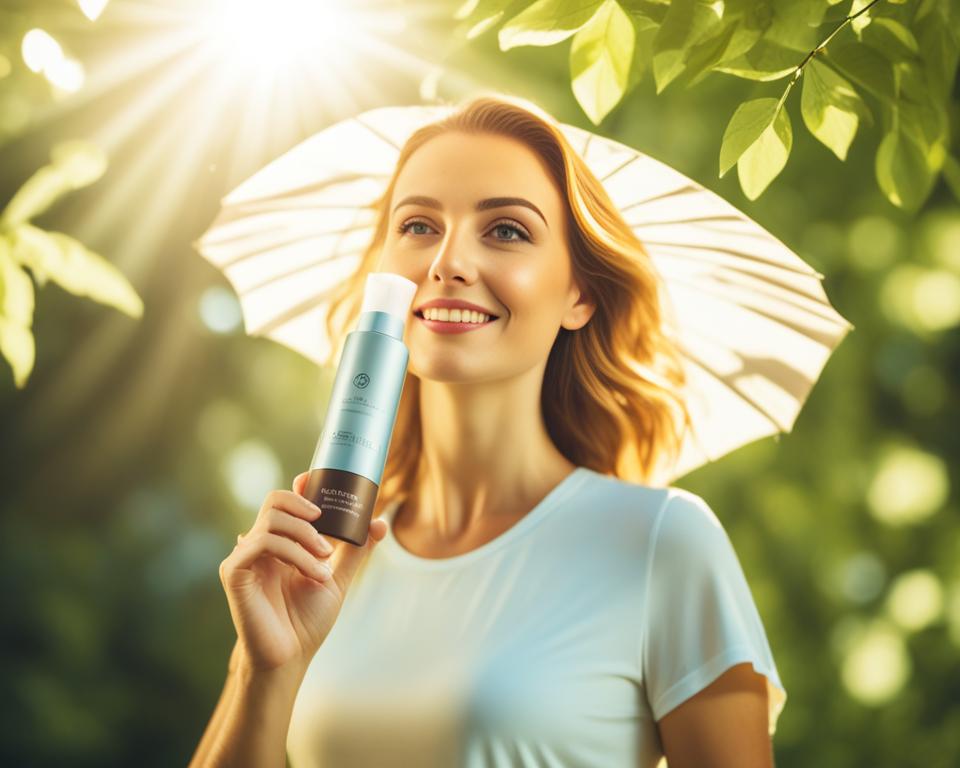
The Link Between Sun Exposure and Skin Cancer
Understanding the link between excessive sun exposure and the development of skin cancer is crucial for prioritizing sun protection. Skin cancer is a potentially life-threatening disease that can result from the effects of sun damaged skin.
“Excessive sun exposure can increase your risk of developing skin cancer.”
Sunburns, sun spots, and other visible effects of sun damaged skin are indicators of potential damage to skin cells. Over time, the accumulation of UV radiation can cause genetic mutations, leading to the development of skin cancer.
To minimize the risk of skin cancer, it is essential to adopt sun-safe habits and protect your skin from harmful UV rays. This includes wearing appropriate clothing, using sunscreen with a high SPF, seeking shade during peak sun hours, and regularly examining your skin for any changes or abnormalities.
Types of Skin Cancer
There are three primary types of skin cancer: basal cell carcinoma, squamous cell carcinoma, and melanoma. Basal cell carcinoma and squamous cell carcinoma are the most common and usually less aggressive, while melanoma is less common but can be the most dangerous.
Early detection is key in successfully treating skin cancer. Regular self-examinations and annual full-body skin checks by a dermatologist are critical in identifying any suspicious moles, growths, or changes in your skin.
Preventing Skin Cancer
“Protecting your skin from the sun’s harmful UV rays is the best approach to preventing skin cancer.”
- Apply sunscreen with broad-spectrum protection and a minimum SPF of 30.
- Wear protective clothing, including wide-brimmed hats and long-sleeved shirts.
- Seek shade during peak sun hours, typically between 10 AM and 4 PM.
- Avoid tanning beds, as they also emit harmful UV rays.
Remember, consistent sun protection measures can significantly reduce the risk of skin cancer and help maintain the health and appearance of your skin.
Identifying Sun Spots and Pigmentation Changes
Sun spots and pigmentation changes are common skin concerns that can occur as a result of sun damage. These manifestations are often characterized by the presence of darker or discolored patches on the skin. By recognizing these changes, you can take proactive steps to address them and maintain healthier skin.
Understanding Sun Spots
Sun spots, also known as solar lentigines or liver spots, are flat, brown spots that develop on sun-exposed areas of the skin. They are particularly common in individuals with fair skin and can appear on the face, hands, arms, shoulders, and other parts of the body.
The appearance of sun spots on the skin can vary in size, shape, and intensity of pigmentation.
These dark patches are the result of an overproduction of melanin, the pigment responsible for skin and hair color. Sun spots typically develop after years of sun exposure, as UV radiation triggers the production of melanin to protect the skin from further damage.
While sun spots are typically harmless, it is important to monitor them for any changes in size, shape, or color. In some cases, they may indicate the presence of more serious skin conditions, such as skin cancer.
Treatment Approaches for Sun Spots
If you are concerned about sun spots and pigmentation changes, there are various treatment options available to help diminish their appearance:
- Topical Creams and Serums: Over-the-counter and prescription strength creams containing ingredients like hydroquinone, retinol, or kojic acid can help fade sun spots over time.
- Laser Therapy: Laser treatments, such as intense pulsed light (IPL) therapy, can target and break down the excess pigmentation, leading to a more even skin tone.
- Chemical Peels: These treatments involve the application of a chemical solution to the skin, which exfoliates the top layers and helps fade sun spots.
It is important to consult with a dermatologist or skincare professional to determine the most appropriate treatment plan for your specific skin concerns.
Lifestyle Changes for Sun Damage Prevention
Preventing sun damage and maintaining healthy skin requires more than just sunscreen. Making a few simple lifestyle changes can go a long way in protecting your skin from harmful UV rays. Here are some key habits and choices that can help prevent sun damage and promote healthier skin:
Eat a Skin-Healthy Diet
Include foods rich in antioxidants, such as berries, leafy greens, and nuts, in your diet. These nutrients help fight free radicals caused by sun exposure and promote skin repair and rejuvenation.
Stay Hydrated
Drinking an adequate amount of water keeps your skin hydrated and helps flush out toxins. Well-hydrated skin is more resilient and less prone to sun damage.
Seek Shade During Peak Hours
When the sun’s rays are strongest, typically between 10 am and 4 pm, stay in the shade as much as possible. This reduces direct UV exposure and lowers the risk of sun damage.
Wear Protective Clothing
Cover up exposed skin with protective clothing, such as long-sleeved shirts, wide-brimmed hats, and sunglasses with UV protection. This helps create an additional barrier between your skin and the sun’s harmful rays.
Practice Sun-Safe Habits
- Apply a broad-spectrum sunscreen with an SPF of 30 or higher to all exposed skin, even on cloudy days.
- Reapply sunscreen every two hours or immediately after sweating or swimming.
- Use lip balm with SPF to protect your lips from sun damage.
- Avoid tanning beds and artificial tanning methods, as they can also cause sun damage.
Incorporating these lifestyle changes into your daily routine can significantly reduce the risk of sun damage and promote overall skin health. Remember, prevention is key when it comes to protecting your skin from the harmful effects of UV exposure.
| Fruits | Vegetables | Nuts and Seeds |
|---|---|---|
| Blueberries | Kale | Almonds |
| Strawberries | Spinach | Walnuts |
| Oranges | Carrots | Flaxseeds |
The Role of Antioxidants in Sun Protection
When it comes to protecting your skin against the damaging effects of the sun, there is a powerful ally that can play a key role – antioxidants. These beneficial substances are known for their ability to neutralize harmful free radicals and reduce the oxidative stress caused by UV radiation. By incorporating antioxidants into your skincare routine, you can enhance your skin’s defense against sun damage and maintain a youthful appearance.
Antioxidants work by counteracting the harmful effects of free radicals, which are unstable molecules generated by exposure to UV rays. These free radicals can damage the skin’s DNA, proteins, and lipids, leading to premature aging, wrinkles, and other visible signs of sun damage. By scavenging these free radicals, antioxidants help protect the skin from oxidative stress and minimize the long-term effects of sun exposure.
The role of antioxidants in sun protection goes beyond just neutralizing free radicals. These remarkable substances also contribute to repairing and rejuvenating the skin. They can help to reduce inflammation, promote collagen production, and enhance the skin’s ability to retain moisture. By strengthening the skin barrier and supporting its natural repair processes, antioxidants play a vital role in preventing and treating the visible effects of sun damaged skin.
Incorporating antioxidants into your skincare routine is relatively easy. Look for skincare products that contain antioxidants such as vitamins C and E, green tea extract, resveratrol, or coenzyme Q10. These ingredients can provide a protective shield against sun damage and help maintain skin health.
The Benefits of Antioxidant-Rich Foods
While topical application of antioxidants is effective, it’s also important to nourish your skin from within. Consuming a diet rich in antioxidants can provide additional support for sun protection. Include foods such as berries, citrus fruits, leafy greens, nuts, and seeds, which are known for their high antioxidant content. These foods can help fortify your skin’s natural defense mechanisms and promote overall skin health.
Did you know? Antioxidants not only protect your skin from the harmful effects of the sun but also help to keep your skin looking younger and more radiant.
By understanding the role of antioxidants in sun protection, you can make informed choices about your skincare routine and lifestyle. Remember, sun damage is a cumulative process, and proactive measures can help minimize its effects. With the power of antioxidants on your side, you can enjoy the sun safely while maintaining the health and beauty of your skin.
Nourishing Your Skin with Proper Skincare
After sun damage has occurred, it’s essential to implement effective skincare routines and products to repair and restore your skin. By incorporating key ingredients and techniques into your daily regimen, you can optimize your skin’s health and appearance, treating sun damaged skin effectively.
One of the crucial steps to treat sun damaged skin is to cleanse it thoroughly. Look for gentle cleansers that remove dirt, impurities, and excess oil without stripping your skin of its natural moisture. Opt for cleansers containing natural extracts like aloe vera, green tea, or chamomile, as they provide soothing benefits and nourishment to your skin.
Exfoliation is another essential process in treating sun damaged skin. Regular exfoliation helps remove dead skin cells and promotes cell turnover, allowing fresh, healthy skin to emerge. Look for exfoliators that contain alpha-hydroxy acids (AHAs) or beta-hydroxy acids (BHAs) as they can effectively slough away dead skin cells and reveal a brighter complexion. However, be mindful not to over-exfoliate, as it can lead to skin irritation.
Hydration is key when it comes to nourishing sun damaged skin. Look for moisturizers with hydrating ingredients like hyaluronic acid, which attracts and retains moisture in the skin, promoting hydration and plumpness. Additionally, opt for moisturizers with antioxidants like vitamin C and E to provide protection against free radicals and further damage.
The use of serums can also enhance the effectiveness of your skincare routine. Consider incorporating serums containing ingredients like retinol, vitamin C, or niacinamide. These powerful ingredients can help promote skin repair, reduce the appearance of wrinkles, and even out skin tone.
When treating sun damaged skin, it’s important not to forget the delicate eye area. Look for eye creams specifically formulated to target signs of aging and sun damage, addressing concerns such as fine lines, crow’s feet, and dark circles. Choose eye creams with ingredients like peptides, hyaluronic acid, and caffeine to rejuvenate and brighten the eye area.
To further enhance your skincare routine, consider incorporating face masks and treatments specific to sun damaged skin. Look for masks formulated with soothing ingredients like aloe vera or chamomile to provide relief and hydration to your skin. You can also explore treatments such as chemical peels or microdermabrasion, which can help exfoliate and rejuvenate sun damaged skin.
Remember that consistency is key when treating sun damaged skin. Stick to your skincare routine and be patient as it takes time for your skin to repair and heal. With proper care and the right products, you can enhance your skin’s health and restore its natural radiance and vitality.
Seeking Professional Help for Sun Damage
If you are dealing with sun damaged skin and looking for effective treatment options, seeking professional help can provide you with expert guidance and solutions. Dermatologists have a wealth of knowledge and experience when it comes to addressing the visible effects of sun damage on the skin.
One popular treatment option for sun damaged skin is laser therapy. This non-invasive procedure uses targeted laser technology to stimulate collagen production, reducing the appearance of fine lines, wrinkles, and sunspots. Laser therapy can also help improve skin texture and tone, giving you a more youthful and rejuvenated appearance.
“Laser therapy is a versatile and effective treatment for sun damaged skin. By targeting specific areas, it can address a wide range of concerns, from pigmentation changes to skin texture. The results can be remarkable, helping patients reclaim healthier and more radiant skin.” – Dr. Emily Thompson, Dermatologist
Another option for treating sun damaged skin is chemical peels. These peels involve the application of a chemical solution to the skin, which helps exfoliate the damaged outer layer. By removing dead skin cells, chemical peels can reveal fresh, revitalized skin underneath. This treatment can improve the appearance of sunspots, uneven skin tone, and even reduce the appearance of fine lines and wrinkles.
It’s important to consult with a dermatologist to determine the most suitable treatment for your specific skin concerns. They can assess your skin condition, discuss your goals, and recommend a personalized treatment plan. They may also suggest complementary treatments and skincare routines that can further enhance the results of professional procedures.
Benefits of Seeking Professional Help
- Expert knowledge and guidance from experienced dermatologists.
- Access to advanced treatment options and technologies.
- Personalized treatment plans tailored to your specific skin concerns.
- Enhanced results with complementary treatments and skincare routines.
Don’t let sun damaged skin hinder your confidence or affect your overall skin health. By seeking professional help, you can explore effective treatment options that address your unique concerns and restore your skin’s vibrancy.
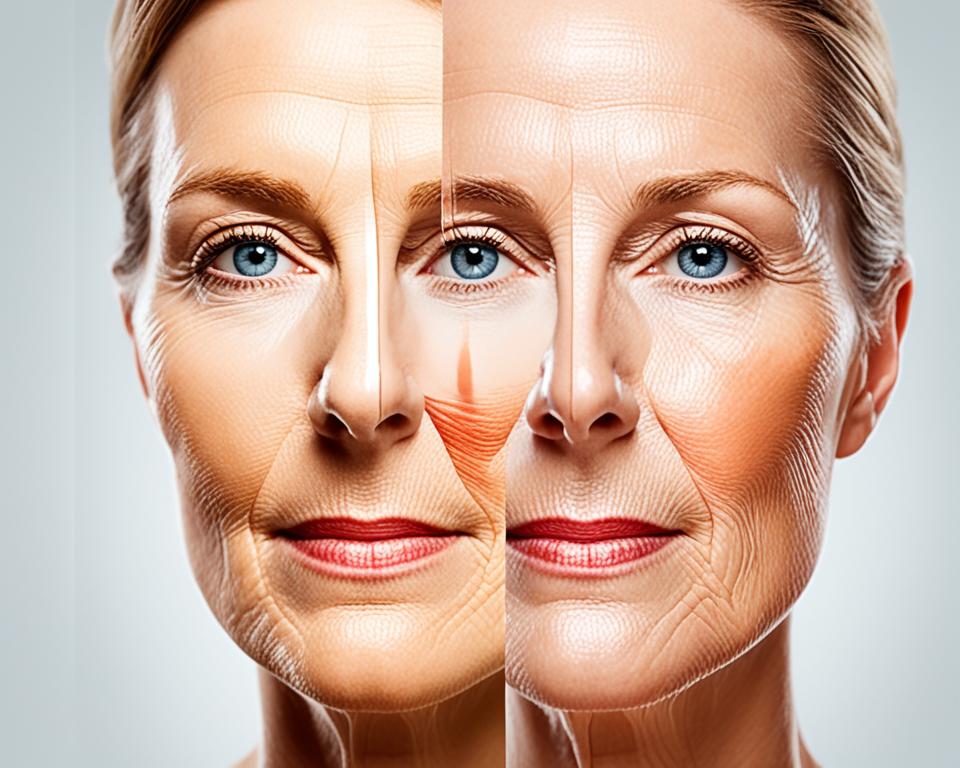
Summary
When it comes to treating sun damaged skin, the expertise of dermatologists can be invaluable. Laser therapy and chemical peels are just a few examples of the professional treatment options available. By consulting with a dermatologist, you can receive personalized guidance and effective solutions to rejuvenate your skin and restore its health and radiance.
Sun Safety Tips for All Seasons
Protecting your skin from the sun’s harmful rays is essential throughout the year. While many people associate sun damage with summer, the truth is that UV radiation can affect your skin in every season. By following these sun safety tips, you can prevent sun damage and maintain healthy skin all year long.
1. Wear Sunscreen Daily
Regardless of the season, applying sunscreen should be a part of your daily skincare routine. Choose a broad-spectrum sunscreen with a minimum SPF of 30, and don’t forget to reapply every two hours. Pay extra attention to areas that are often overlooked, such as the ears, back of the neck, and hands.
2. Seek Shade
When the sun is at its strongest, typically between 10 a.m. and 4 p.m., try to seek shade as much as possible. This can help reduce your overall UV exposure and minimize the risk of sun damage to your skin. If shade is not readily available, consider using an umbrella or wearing a wide-brimmed hat for added protection.
3. Cover Up
Wearing protective clothing is a great way to shield your skin from the sun’s rays. Opt for lightweight, long-sleeved shirts, pants, and skirts made from tightly woven fabrics. Additionally, wearing UV-protective sunglasses can help protect your eyes and the sensitive skin around them.
4. Be Mindful of Reflective Surfaces
Keep in mind that certain surfaces can reflect and intensify UV radiation onto your skin. This includes snow, water, sand, and concrete. Take extra precautions when you’re near these reflective surfaces, as they can increase your risk of sunburn and sun damage.
5. Stay Hydrated
Proper hydration is essential for maintaining healthy skin, regardless of the season. Drinking an adequate amount of water can help keep your skin hydrated and enhance its natural protective barrier. Remember to drink water throughout the day, even if you don’t feel thirsty.
6. Use Protective Lip Balm
The skin on your lips is delicate and often overlooked when it comes to sun protection. Protect your lips by applying a lip balm with SPF regularly. This will help prevent sunburn, dryness, and potential long-term damage.
7. Don’t Forget Your Scalp
Your scalp is just as susceptible to sun damage as the rest of your skin. If you have thinning hair or a bald spot, make sure to protect your scalp from the sun’s rays. Wear a wide-brimmed hat or use a sunscreen specifically designed for the scalp.
“Sun safety is not just for the beach. It’s a year-round commitment to ensure the health and vitality of your skin.”
By incorporating these sun safety tips into your daily routine, you can effectively prevent sun damage to your skin. Remember, protecting your skin from the sun is a long-term investment in your overall health and well-being.
| Season | Sun Safety Tips |
|---|---|
| Spring | – Apply sunscreen before heading outdoors – Wear protective clothing – Seek shade whenever possible |
| Summer | – Apply sunscreen generously and frequently – Stay hydrated – Limit sun exposure during peak hours |
| Fall | – Continue using sunscreen – Cover up with long sleeves and pants – Keep lips moisturized with SPF balm |
| Winter | – Use sunscreen, especially on sunny days – Protect skin from cold winds with moisturizing creams – Wear hats and scarves for extra warmth and sun protection |
Conclusion
In conclusion, understanding the effects of sun damaged skin is crucial for maintaining healthy and radiant skin. Through the exploration of sun damaged skin pictures, we have seen the visual impact and consequences of UV exposure. By recognizing the signs of sun damaged skin, we can take proactive steps to protect ourselves.
Sun protection is of utmost importance in preventing sun damage. By following sun safety tips, making lifestyle changes, and nourishing our skin with proper skincare, we can minimize the risk of sun damage and maintain healthier skin.
If sun damage does occur, early detection and effective treatment are key. Seeking professional help and exploring different treatment options can help in repairing and restoring sun damaged skin. Remember, sun protection, early detection, and effective treatment are the pillars to keeping our skin healthy and radiant.
